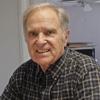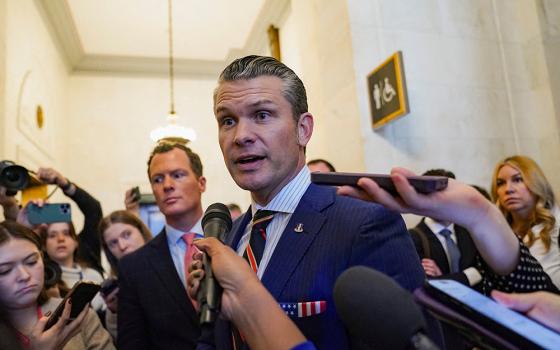
SAN JOSE, Calif. -- Theologian Paul Lakeland, addressing several hundred Catholic theologians here today, called for a good dose of additional humility as our church looks out at the world.
His talk came on the second day of the 66th annual gathering of the Catholic Theological Society of America, the largest body of Catholic theologians in North America.
Lakeland is professor of Catholic Studies and chair of the Center for Catholic Studies at Fairfield University in Fairfield, Connecticut.
In a talk titled, “I want to be in that number: Desire, Inclusivity and the Church,” Lakeland used both contemporary literature and gospel imagery, primarily the parable of the Good Samaritan, to build his humility case.
But first he asked: “Why should we focus on the virtue of humility in a presentation on the conference theme of “all the saints”? Answering his question, he said a good reason is that “humility is a defining virtue of holiness.”
The more important ecclesiological reason for attention to humility, he said, is that without it any examination of “all the saints” will inevitably gravitate towards the vice of exclusion.
“Indeed, I feel comfortable saying that many of our ecclesial ills today are products of the sin of exclusion and can be addressed by attention to the virtue of humility.”
Said Lakeland: “Whether we are engaged in invidious and often ignorant comparisons between the holy church and the sinful world or spiritually empty comparisons between the fullness of truth in ‘our’ tradition and the defects of others, we are about the business of exclusion, sweeping aside God’s holy mystery to impose our fallible human considerations about where saints can be found.
“Inside the church similar crimes are being committed when a sub-group of the community, in the name of its convictions of what purity looks like and persuaded that it can speak for God, marginalizes others, whether they are the divorced, or gays and lesbians, or religious sisters going about their jobs, whether they are working in Catholic hospitals or in Congress, or, indeed, even if they are just theologians.”
Lakeland then explored several facets of ecclesial humility, building his talk, in part on passages from the writings of Flannery O’Connor and the Good Samaritan. He also quoted from the writings of Fordham professor of theology, Elizabeth Johnson.
“Elizabeth Johnson, in whose shadow anyone writing on this topic sits, has written that because ‘the communion of saints does not limit divine blessing to its own circle… it comprises all living persons of truth and love.’ … Most if not all of us are confident that salvation is offered to all, not merely to the baptized, or theists, or believers in ‘the transcendent.’”
Lakeland went on: “We should all daily be chastened by the warning in Matthew 25 that the Last Judgment will be a day of great surprises.”
Yves Congar, Lakeland said, once wrote that church and world are not to be imagined “like two crowned sovereigns looking sideways at one another as they sit on the same dais” but “much more like the Good Samaritan holding in his arms the half-dead man, whom he will not leave because he has been sent to help him.”
“In the theological moment of celebration, the identification of the church with the Good Samaritan reaching out to the wounded victim is an important assertion of the priority of mission that draws attention to the fact that the church throughout history has been a source of succor and consolation to suffering people, Catholic or not.
“In the Catholic tradition in particular, the many orders of religious women have always made an enormous contribution in the fields of nursing and education. Religious, both men and women, exercised a preferential option for the poor many centuries before the phrase was coined. Even today, Catholic Charities is the largest private network of social service organizations in the U.S., much of their work being direct aid to the needy, Christian or not. Whether one calls this work humanization, pre-evangelization or preparation for the Gospel, it is an integral component of mission and witness without which the proclamation of the good news of Jesus Christ is incomplete.
“The self-referentiality or centripetal tendencies of the Church are evident in ecclesial life today. They are the shadow side of the good that we do and the holy community that we are, but they follow clearly from an undialectical emphasis on celebration. In terms of the parable of the Good Samaritan, they are what happens when we rejoice in our identification with the model of concern for others and forget the disquieting context in which the parable is told. If we are the Good Samaritan who comes to the aid of the victim, then we are also the priest and Levite who is too busy about the ‘things of God’ to be aware of the cries of the victim.
He went on, saying that the parable of the Good Samaritan is less a story about doing good than it is about “breaking boundaries.”
“Even more, the story insists that there are no boundaries to neighborliness. Love your neighbor as yourself is not about limits (“who is my neighbor?”) but about the absence of limits (“Everyone!”). The lawyer, the priest and the Levite work within the Law and want to know what it requires. Jesus teaches them to abandon it. The consequences of this parable for construing the right relationship between church and world are thus considerable.”
In her “Hesitations Concerning Baptism” Simone Weil presents a challenging set of reflections on the presence of the church in the world cast in the form of an explanation of why belief in God does not mean that she will necessarily seek to enter the Church, Lakeland said. 
“Weil writes that the fear she has for the church is that it can too easily become an ‘us’ over against the ‘them’ of the world.
t
Lakeland said that Weil points to the dangers of the kind of ecclesial xenophobia, which dogged the church in the past particularly in what John O’Malley calls the ‘long nineteenth century,’ stretching from the French Revolution to the eve of Vatican II.”
Lakeland went on, saying it is hard not to see something like the Syllabus of Errors or the definition of papal infallibility at Vatican I, however formally correct they may have been in their times, as driven by a determination to assert the rightness of the church over against the wrongness of the world.
“Where, indeed, in that whole long century is there any ecclesiastical humility in face of the world? And if after Vatican II we have largely got beyond the demonization of the religious other, it still remains true that when the church uses language like that in Dominus Iesus, or creates an “ordinariate” for conservative Anglicans fleeing their church, however formally correct these may be, they do nothing whatsoever to draw the church and the world closer together.”
t
“ When the Second Vatican Council fathers said that there is a real sense in which the church must learn from the world, they meant that we need its help in order to be more fully the church of God.
Lakeland concluded, saying a critical ecclesiology is one that “takes seriously the limitations of the church.” “That the church exists not for itself but for the sake of the world, the saving mission which God has entrusted to the church, is a given of contemporary ecclesiology. What is not always so clear is that in being a sacramental community it is at one and the same time positive and negative. It is the love of God for the world, and it is also in need of God’s love for the world. It is God as present and God as absent. It is graced and sinful. It is the place of ordered desire and of disordered desire. It seeks integrity and falls short. It heals and it needs healing, it is the Good Samaritan embracing the victim and the victim embraced by the Good Samaritan. It is the Church that teaches and the Church that is always in need of being taught.
“Because the world needs the Gospel as much as ever, it needs a church that doesn’t think it has all the answers but that is prepared to work in solidarity with others in the search for the truth that will set us all free, a church that sees dialogue with our secular world as an encounter of grace with grace and sinners with sinners, and saints with saints.”
[Tom Fox is NCR editor.]
|
Coverage from the Catholic Theological Society of America:
|




